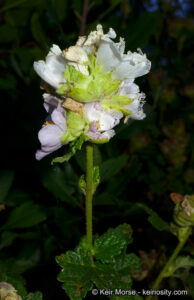Malacothamnus palmeri
- G3 Vulnerable – NatureServe (1990)
The Los Padres National Forest contains a wide range of ecosystems, spanning from coastal and marine habitats to redwood forests, mixed conifer forest, oak woodlands, grasslands, and chaparral. Thus it is one of the most botanically rich areas in the country, home to over 1,200 plant species, including a number of endangered, threatened and sensitive plants.
The Malacothamnus genus, within the Malvaceae (or Mallow) family, is native to California, and the Malacothamnus palmeri species is endemic (only found in) to San Luis Obispo and Monterey Counties. M. palmeri spp. are perennial, deciduous shrubs that generally flower from May-August.
The following three subspecies of bush mallow found in the Los Padres National Forest have been classified as List 1B by the California Native Plant Society (CNPS). CNPS defines List 1B as “plants rare, threatened, or endangered in California and elsewhere.” Basically, plants on this list are rare throughout their range, and have declined significantly over the last century.
The Malacothamnus genus is a fire-follower that can regenerate from root sprouts in mild fires or by seedling germination in areas cleared by fire. Altered fire regimes (too frequent fires and fire suppression policies) have contributed to the decline in plant population size and historical range. Plant population declines can also be attributed to habitat destruction from urban sprawl and agriculture.
Carmel Valley Bush Mallow
Malacothamnus palmeri var. involucratus
- Sensitive – U.S. Forest Service
- Sensitive – Bureau of Land Management
- Rare Plant Rank 1B.2 – California Native Plant Society
The Carmel Valley bush mallow grows in chaparral, foothill woodland and coastal scrub ecosystems. It is known from one location in the Los Padres National Forest in the Santa Lucia Mountains, between Morro Bay and Atascadero. It also grows near the forest in several locations in Monterey County. This plant is threatened by development, grazing, military operations, and road/trail construction.
Arroyo Seco Bush Mallow
Malacothamnus palmeri var. lucianus
- Sensitive – U.S. Forest Service
- Rare Plant Rank 1B.2 – California Native Plant Society
The Arroyo Seco bush mallow is endemic to the Santa Lucia Mountains of Monterey County. This plant has been positively identified in only one area in the Los Padres National Forest. M. palmeri var. lucianus occurs in chaparral and canyon live oak woodland at elevations of about 2,800 feet. It is generally found on gravel banks and sandstone rocks on west and southwest-facing slopes in full sunlight. In contrast to the Carmel Valley bush mallow, the Arroyo Seco bush mallow leaves are a paler green, the leaves have stellate hairs on both the upper and lower surfaces, and the petal length is longer (20-30 mm). Many occurrences of this plant are along a road, and so the primary threat is road maintenance activity.
Santa Lucia Bush Mallow
Malacothamnus palmeri var. palmeri
- Sensitive – U.S. Forest Service
- Rare Plant Rank 1B.2 – California Native Plant Society
Endemic to SLO County and possibly Monterey County; found in the LPNF only along Cuesta Ridge, on rocky chaparral slopes up to 1200 feet elevation. The Santa Lucia bush mallow is believed to occur in one area of the Los Padres National Forest, but positive identification of M. palmeri var. palmeri is needed because this plant may have been mistaken for the Carmel valley bush mallow, given that both varieties occur in the same area. The Santa Lucia bush mallow grows in rock chaparral at elevations of about 60-360 meters (200-1200 feet). The CNPS considers M. palmeri var. palmeri to be at risk in portions of its range due in part to altered fire regimes.
Protecting the Bush Mallow in the Los Padres
ForestWatch is currently working to protect the bush mallow, and the chaparral ecosystem in general, from overly-frequent burning that could have detrimental impacts on this ecosystem. We are also working to improve fire management on the Los Padres National Forest to better protect rare species, sensitive chaparral communities, and wildlife. ForestWatch is also working to ensure that these plants are protected from disturbances such as encroaching development and road maintenance.







